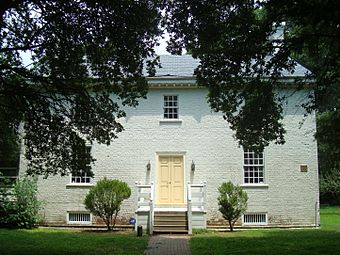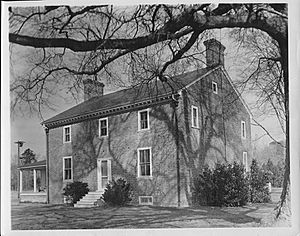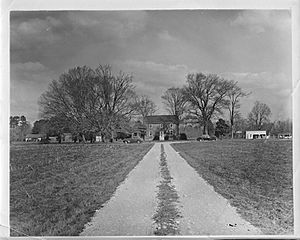Upper Wolfsnare facts for kids
|
Upper Wolfsnare
|
|

Upper Wolfsnare home on July 4, 2012
|
|
| Location | 2040 Potter's Road, E of jct. of Rtes. 635 and 632, Virginia Beach, Virginia |
|---|---|
| Area | 3 acres (1.2 ha) |
| Built | 1759 |
| NRHP reference No. | 75002119 |
Quick facts for kids Significant dates |
|
| Added to NRHP | March 26, 1975 |
Upper Wolfsnare, also known as Brick House Farm until 1939, is a historic brick house. It was built around 1759 in the Georgian style in Virginia Beach, Virginia. Thomas Walke III built this home.
Contents
History of Upper Wolfsnare
The Walke Family and Early Years
Thomas Walke III was an important officer in the British Army. His son, Thomas Walke IV, played a role in early American history. He was a member of the Virginia Ratifying Convention in 1788. This group voted to approve the United States Constitution. Thomas Walke IV was one of two representatives from Princess Anne County.
The first Thomas Walke (Thomas I) came to this area in 1662 from Barbados. He started a trading business between the Virginia colony and Barbados. This trade likely included goods like rum and also involved the practice of slavery. He had strong connections with William Byrd I, another important figure.
When Thomas Walke III passed away in 1761, his son, Thomas Walke IV, inherited a large property. It was a plantation of about 7,000 acres (2,833 hectares). He also inherited 55 enslaved people who were forced to work on the plantation. In 1783, after the American Revolution, Thomas Walke IV tried to get back enslaved people who had been taken by the British. Some of these individuals later found their way to Nova Scotia. Thomas Walke IV supported American independence, while most people in Princess Anne County remained loyal to Britain.
Ownership Changes and Preservation
The Upper Wolfsnare property stayed with the Walke family until 1822. At that time, it was about 300 acres (121 hectares). After 1822, the property was sold many times. Today, it is much smaller, about 3 acres (1.2 hectares). Since 1966, the Princess Anne County/Virginia Beach Historic Society has owned the house. People still live in the house today.
You can visit the house for tours during the summer, but only on certain days.
Location and Design of the House
Why the Name "Upper Wolfsnare"?
The house got its name because it is located next to Wolf Snare Creek. It sits on the upper part of the creek. The area around the house can be noisy. It is located between Naval Air Station Oceana and Interstate 264. At one point, the house was almost torn down to make way for a highway ramp. However, people who wanted to save old buildings worked hard to protect it.
Features of the Historic Home
The path leading to the house at 2040 Potter's Road is lined with many trees, including beautiful crepe myrtles. From Potter's Road, trees mostly hide the house. Beyond the trees, the land is open, flat, and marshy.
The house has two stories and is built with a special brick pattern called Flemish bond brickwork. Inside, a hallway runs through the center of the house. It has decorative raised paneling and wainscoting on the walls.
Upper Wolfsnare is recognized as an important historical site. It was listed in the Virginia Landmarks Register in 1974. The house was also added to the US National Register of Historic Places in 1975.
See also






